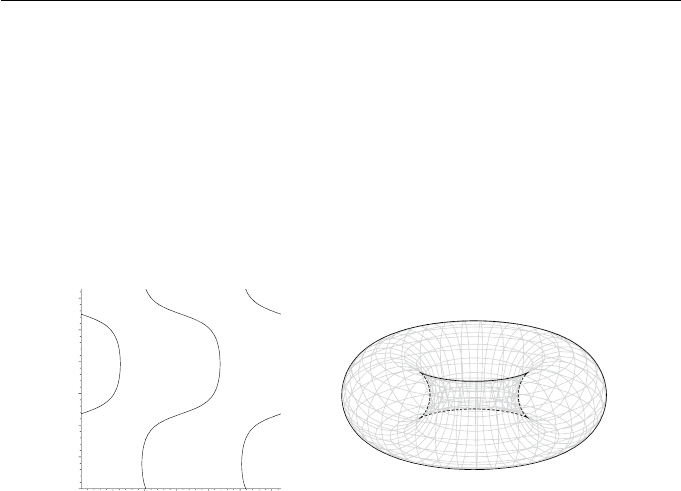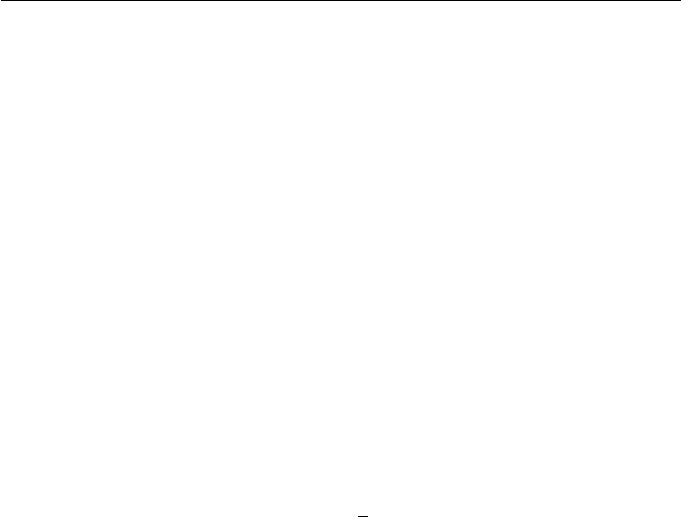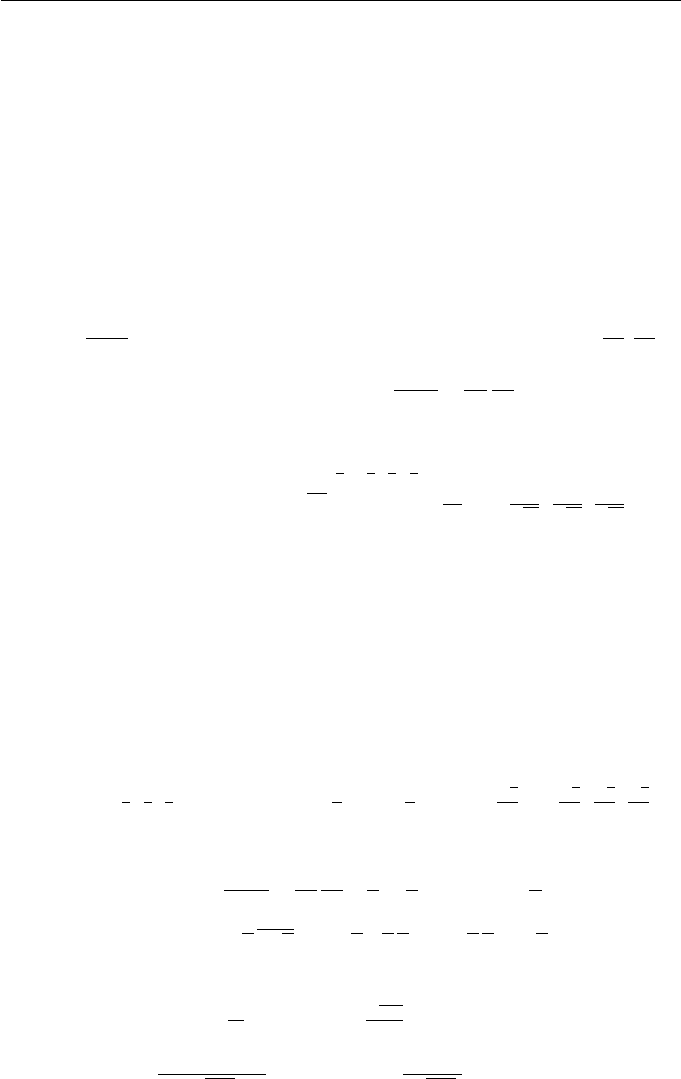Marsh D. Applied Geometry for Computer Graphics and CAD
Подождите немного. Документ загружается.


318 Applied Geometry for Computer Graphics and CAD
silhouette can be obtained, for instance, by using (11.24) to solve for s,and
then substituting for s in the parametric equation of the torus. Figures 11.16(a)
and (b) show the curve in the (s, t)-parameter space of the torus, and the
corresponding silhouette when r =5,R =10andV(50, 50, 25). Part of the
silhouette curve is drawn using a dashed line to indicate that that it is hidden by
the torus in the given projection. Observe that the parameter-space curve has
two branches (taking the periodicity of the domain in account). Each branch
corresponds to a connected component of the silhouette curve.
0
1
2
3
4
5
6
1234
5
6
0
(a) (b)
Figure 11.16 Silhouette of a torus
In general, it is not possible to obtain an analytical solution for the silhou-
ettes of a surface. Silhouettes of more complex surfaces such as B´ezier and B-
spline surfaces are found by numerical methods. One approach is similar to that
used in Example 11.8. For a parametric surface x(s, t)=(x(s, t),y(s, t),z(s, t))
the normal direction is (x
s
× x
t
). The silhouette for a parallel projection is
given by the vector triple product
V · (x
s
× x
t
)=0. (11.25)
Equation (11.25) defines a curve C(s, t)=0inthe(s, t) parameter space of
the surface. Points of this curve are obtained numerically using, for instance,
a marching method or subdivision (see [13]). The points of this curve corre-
spond to the silhouette points of the surface. Perspective projections can be
determined similarly.
The CAD drawing in Figure 11.17(a) has been obtained by projecting the
edges and silhouettes of the surfaces. The CAD drawing is completed by per-
forming a hidden line computation to determine the segments of the edges
and silhouettes that are visible. The silhouette plays an important part in the
hidden line calculation. In Figure 11.17(b), the line AC has a visible segment

11. Rendering 319
between points A and B, and an invisible segment BC that lies behind the
hemisphere. Similarly, the line DF has a visible segment between points D and
E, and an invisible segment EF that lies behind one of the blocks. Observe
that changes in the visibility of an edge (or a silhouette) correspond to points
in the viewplane where the projected image of the edge (or silhouette) inter-
sects the projected images of itself, and other edges and silhouettes. However,
not all such intersections give rise to a change in visibility, and other infor-
mation about the surfaces must be taken into account. Changes in visibility
can also arise at apparent cusps of a silhouette, that is, silhouette points that
correspond to cusps of the apparent contour. For instance, the visibility of the
torus silhouette in Figure 11.16 changes at two of the four apparent cusps.
A
B
C
D
E
F
(a) (b)
Figure 11.17 CAD drawing with (a) hidden lines removed and (b) hidden
lines drawn faint
EXERCISES
11.12. Show that VQP
T
= PQV
T
.
11.13. Verify that Equations (11.15) and (11.23) are equivalent.
11.14. Compute the silhouette curves of the cylinder x
2
+ y
2
= 1 for the
perspective projection with viewpoint (λ, 0, 0), for λ>1orλ<−1.
11.15. Compute the silhouette curve of the quadric 4x
2
−2xz+y
2
−z
2
−4=0
for the perspective projection with viewpoint (10, 0, 0).
11.16. Write a computer program (or use a computer package) that obtains
the silhouettes of a quadric surface. The user should input the co-
efficients of the quadric and the viewpoint, and the program should
determine the conic silhouette in parametric form. Care should be
taken to identify the cases when there are no silhouette points; for
instance, when the viewpoint lies inside a sphere or ellipsoid. The

320 Applied Geometry for Computer Graphics and CAD
cases when the silhouettes are linear may need to be treated sepa-
rately.
11.17. Consider the surface of revolution of the curve (f(u), 0,g(u)) (f(u) =
0) about the z-axis given by x(u, v)=(f(u)cosv,f(u)sinv, g(u)).
Show that the silhouettes for a parallel view in the z-direction are
circles lying in planes that are perpendicular to the z-axis.
11.18. Show that, for a parallel projection in the z-direction, the silhouette
curves of the torus of Example 11.5 are circles.
11.19. Show that, for a parallel projection in the x-direction, the silhouette
curves of the torus of Example 11.5 are circles.
11.6 Shadows
A shadow is a region of a object’s surface where illumination is reduced due to
the obstruction of light sources by other objects in the scene. The amount of
diffuse light is reduced, but there is still a contribution of ambient light. When
a shading algorithm is applied to a scene, shadows appear in regions where
the intensities are significantly less than the surrounding intensities. Shading
algorithms do not always produce a satisfactory result. For some surfaces it is
possible to determine the boundary of the shadow region mathematically by
applying a projection with the light source as the viewpoint and the surfaces
of objects in the scene as “viewplanes”. The boundaries of an object’s shadow
are the projected images of edges and silhouettes of the obscuring objects onto
the surface.
The shadows cast by a polygonal surface onto a planar surface are straight-
forward to compute. A polygon is a union of triangular planar facets, and it
follows from Exercise 11.4 that each facet either has no silhouette, or is entirely
in silhouette and does not contribute to the shadow. Therefore, a polygon casts
a shadow that is bounded by the projected images of the polygon edges: these
can be found using the method of Section 4.3.
Example 11.9
The scene in Figure 11.18(a) consists of a sphere, with radius
1
2
and centre
1
2
,
1
2
, 1
, that has been embedded in a unit cube. The shadow cast onto the
plane z = 0 is determined by (i) computing the silhouette of the sphere, (ii)
projecting the silhouette and the edges of the cube using the light source as
viewpoint and the flat surface as viewplane, and (iii) shading the bounded

11. Rendering 321
shadow region. The unit cube, viewpoint (−1, 0, 2) and viewplane z =0are
-1
0
1
2
3
4
0
1
2
0
1
2
V
V
(a) (b)
Figure 11.18
as given in Example 4.18 and so the projection matrix M has already been
determined. The silhouette of the sphere was obtained in Example 11.7. The
projected vertices of the cube are calculated in the usual manner:
⎛
⎜
⎜
⎜
⎜
⎜
⎜
⎜
⎜
⎜
⎜
⎜
⎝
0001
1001
1101
0101
0011
1011
1111
0111
⎞
⎟
⎟
⎟
⎟
⎟
⎟
⎟
⎟
⎟
⎟
⎟
⎠
⎛
⎜
⎜
⎝
−2000
0 −20 0
−1001
000−2
⎞
⎟
⎟
⎠
=
⎛
⎜
⎜
⎜
⎜
⎜
⎜
⎜
⎜
⎜
⎜
⎜
⎝
000−2
−200−2
−2 −20−2
0 −20−2
−100−1
−300−1
−3 −20−1
−1 −20−1
⎞
⎟
⎟
⎟
⎟
⎟
⎟
⎟
⎟
⎟
⎟
⎟
⎠
,
giving the points with affine coordinates (0, 0, 0), (1, 0, 0), (1, 1, 0), (0, 1, 0),
(1, 0, 0), (3, 0, 0), (3, 2, 0) and (1, 2, 0). The image of the silhouette can be ob-
tained by either computing points on the circle and applying the projection
matrix, or applying the projection matrix to the equation of the circle to yield
a parametric equation for the silhouette image. The shadow is shown in Fig-
ure 11.18(b).
Solutions
Chapter 1
1.2. −4x − 3y +23=0.
1.4. Use Example 1.2 with θ = π/2, to give A
1
A
2
+ B
1
B
2
=0.
1.6. PQ has parametric equation (x(t),y(t)) = ((1 − t) p
1
+ tq
1
, (1 − t) p
2
+ tq
2
)
for 0 ≤ t ≤ 1. Then
L (x(t),y(t)) = (ax(t)+by(t)+c, dx(t)+ey(t)+f)
=(a ((1 − t) p
1
+ tq
1
)+b ((1 − t) p
2
+ tq
2
)+c,
d ((1 − t) p
1
+ tq
1
)+e ((1 − t) p
2
+ tq
2
)+f)
=(1− t)(ap
1
+ bp
2
+ c, dp
1
+ ep
2
+ f)
+ t (ap
1
+ bp
2
+ c, dp
1
+ ep
2
+ f)
=(1− t) L (P)+tL (Q) .
The final line defines the line segment with endpoints L (P)andL (Q).
1.7. (a) A
(4, −1), B
(6, −1), C
(5, 0), D
(4.5, 1). (b) T(−3, 2).
1.8. A mirror image.
1.10. A
(1, −1), B
(3, −1), C
(2, −2), D
(1.5, −3).
1.13. For Rot (π/3) : P
(−0.366, 1.366), Q
(0.634, 3.10), R
(−0.732, 2.732).
For Rot (π/4) : P
(0, 1.414), Q
(1.414, 2.828), R
(0, 2.828).
1.15. No.
1.16. (a) v =(3/5, −4/5) , Sh ((3/5, −4/5) , 4) =
2. 92 −2. 56
1. 44 −0. 92
.
323

324 Solutions
(b) v =(8/10, 6/10), Sh ((8/10, 6/10) , −1) =
1. 48 0. 36
−0. 64 0. 52
.
1.17. Bottom left window is obtained from Square by a scaling of 0.5 in the
y-direction followed by a translation of 1.5 units in the x-direction and
1.5 units in the y-direction.
1.20. Apply Exercise 1.6 with t =0.5.
Chapter 2
2.1. (2, 6, 4), (−1, −3, −2), (1, 3, 2), (4, 12, 8).
2.2. (2, −3, 1), (4, −6, 2) etc.
2.3. (−5, 20, 1), (10, −40, 2).
2.4. Reflexive: M
1
∼ M
1
since M
1
=1M
1
. Symmetric: if M
1
∼ M
2
then M
1
=
µM
2
for some µ =0.ThenM
2
=
1
µ
M
1
and so M
2
∼ M
1
. Transitive: if
M
1
∼ M
2
and M
2
∼ M
3
,thenM
1
= µM
2
and M
2
= ηM
3
for some µ =0
and η =0.ThenM
1
=(µη) M
3
and µη =0.SoM
1
∼ M
3
. Hence ∼ is
an equivalence relation.
2.5. (6, −3, 0).
2.6. (3, 4, 0).
2.7. 3X +4Y − 5W =0.
2.8. (9, 2, 0).
2.9. (−b, a, 0).
2.10. A(1, 1), B(3, 1), C(2, 2), D(1.5, 3).
2.11.
⎛
⎝
200
01.50
001
⎞
⎠
, A
(2, 1.5), B
(6, 1.5), C
(4, 3), D
(3, 4.5).
2.12.
⎛
⎝
010
−100
001
⎞
⎠
, A
(−1, 1), B
(−1, 3), C
(−2, 2), D
(1 − 3, 1.5).
2.13.
⎛
⎝
1/200
02/30
001
⎞
⎠
.

Solutions 325
2.14.
⎛
⎝
cos θ −sin θ 0
sin θ cos θ 0
001
⎞
⎠
.
2.16.
⎛
⎝
0 −30
200
001
⎞
⎠
.
In general, changing the order of transformations results in a different
transformation.
2.17.
⎛
⎝
−400
0 −0. 50
001
⎞
⎠
.
2.18.
⎛
⎝
0 −10
100
−111
⎞
⎠
.
2.19.
(T (−2, 5) · Rot (−π/3))
−1
= Rot (−π/3)
−1
· T (−2, 5)
−1
= Rot (π/3) · T (2, −5)
=
⎛
⎝
0. 50. 866 0
−0. 866 0. 50
2.0 −5.01.0
⎞
⎠
.
2.20.
⎛
⎝
0. 75 0. 3125 0
0. 5 −0. 625 0
−2.0 −2. 51.0
⎞
⎠
.
2.21. (a) A =
⎛
⎝
cos θ sin θ 0
−sin θ cos θ 0
x
0
y
0
1
⎞
⎠
.
(b) A
−1
=
⎛
⎝
cos θ −sin θ 0
sin θ cos θ 0
−x
0
cos θ − y
0
sin θx
0
sin θ − y
0
cos θ 1
⎞
⎠
giving
x
= x cos θ + y sin θ − y
0
sin θ − x
0
cos θ,
y
= −x sin θ + y cos θ − y
0
cos θ + x
0
sin θ.
(d) The equations of the x
-andy
-axes are obtained by setting y
=0
and x
= 0 in the previous equations.

326 Solutions
2.22. T(a, b)wherea = x
0
cos θ − x
0
+ y
0
sin θ − x
1
cos θ − y
1
sin θ + x
1
and
b = −y
0
− x
0
sin θ + y
0
cos θ + x
1
sin θ − y
1
cos θ + y
1
.
2.23.
⎛
⎝
−21 20 0
20 21 0
−80 32 29
⎞
⎠
.
2.26. Bottom left window:
⎛
⎝
100
00.50
1. 51. 51
⎞
⎠
.
2.27.
T (10, 5) · S (20, 20) · T (200, 200) =
⎛
⎝
20 0 0
0200
400 300 1
⎞
⎠
.
2.28. (1, 3, 1) × (4, −2, 1) = (5, 3, −14), giving 5x +3y − 14 = 0.
2.29. (1, −3, 7) × (4, 3, −5) = (−6, 33, 15), giving (−6/15, 33/15).
Chapter 3
3.1. (1.5, 3, 2.5), (0.5, 1.0, 1.5), (0, 0, 2), (1, 0, 0).
3.2. (3, 4, 1, 0), (7, 2, 0, 0).
3.3. (a)
⎛
⎜
⎜
⎝
0. 7071 0. 7071 0 0
−0. 7071 0. 7071 0 0
0010
0001
⎞
⎟
⎟
⎠
.
(b)
⎛
⎜
⎜
⎝
1.00 0 0
0 −2. 5981 −1. 50
00. 5 −0. 8660 0
2.02. 5 −4. 3301 1.0
⎞
⎟
⎟
⎠
.
(c) Translate (1, 0, −11/3) to the origin. Plane is 6x − 6y +3z =0and
R =(2/3, −2/3, 1/3). Then sin θ
x
=(−2/3) /
1
3
√
5
= −
2
5
√
5, cos θ
x
=
(1/3) /
1
3
√
5
=
1
5
√
5, sin θ
y
=2/3, cos θ
y
=
1
3
√
5, giving
⎛
⎜
⎜
⎝
0. 1111 0. 8889 −0. 4444 0
0. 8889 0. 1111 0. 4444 0
−0. 4444 0. 4444 0. 7778 0
−0. 7407 0. 7407 −0. 3704 1.0
⎞
⎟
⎟
⎠
.

Solutions 327
(d) Then Q − P =(6, 2, 3), and hence R =(6/7, 2/7, 3/7). Then sin θ
x
=
(2/7) /
1
7
√
13
=
2
13
√
13, cos θ
x
=(3/7) /
1
7
√
13
=
3
13
√
13, sin θ
y
=
6/7, and cos θ
y
=
1
7
√
13, giving
⎛
⎜
⎜
⎝
0. 5049 0. 6713 0. 5426 0
0. 2427 −0. 7137 0. 6571 0
0. 8283 −0. 2001 −0. 5233 0
−0. 9092 0. 7713 1. 3043 1.0
⎞
⎟
⎟
⎠
.
3.4. (−11, 5, 27).
3.5. 10x +16y + z −25 = 0.
3.8. (a) The points are either collinear or lie on a plane through the origin.
3.9. (p
12
,p
20
,p
01
,p
03
,p
13
,p
23
)=(x
1
y
2
− x
2
y
1
,x
2
y
0
− x
0
y
2
,x
0
y
1
− x
1
y
0
,x
0
−
y
0
,x
1
−y
1
,x
2
−y
2
), so ω =(x
0
−y
0
,x
1
−y
1
,x
2
−y
2
)=P − Q and v =
(x
1
y
2
−x
2
y
1
,x
2
y
0
−x
0
y
2
,x
0
y
1
−x
1
y
0
)=P×Q. Clearly
−−→
QP = P−Q is the
direction vector of the line.
−−→
OP and
−−→
OQ are vectors parallel to the plane
containing P, Q,andO. The normal to the plane is
−−→
OP ×
−−→
OQ = P ×Q.
3.10. (p
03
,p
13
,p
23
)·(p
12
,p
20
,p
01
)=(x
1
y
2
−x
2
y
1
,x
2
y
0
−x
0
y
2
,x
0
y
1
−x
1
y
0
)·(x
0
−
y
0
,x
1
−y
1
,x
2
−y
2
)=(x
0
− y
0
)(x
1
y
2
− x
2
y
1
)+(x
1
− y
1
)(x
2
y
0
− x
0
y
2
)+
(x
2
− y
2
)(x
0
y
1
− x
1
y
0
)=0.
3.11. The rotation is Rot
x
(θ
x
) Rot
y
(−θ
y
) Rot
z
(θ) Rot
y
(θ
y
) Rot
x
(−θ
x
), which
after simplification using r
2
1
+ r
2
2
+ r
2
3
= 1 (following the notation of
Section 3.2.4) yields
⎛
⎜
⎜
⎜
⎜
⎜
⎜
⎜
⎜
⎜
⎜
⎜
⎜
⎜
⎜
⎜
⎝
(cos θ+
r
1
2
(1 − cos θ)
(r
3
sin θ+
r
1
r
2
(1 − cos θ))
(−r
2
sin θ+
r
1
r
3
(1 − cos θ))
0
(−r
3
sin θ+
r
1
r
2
(1 − cos θ))
(cos θ+
r
2
2
(1 − cos θ)
(r
1
sin θ+
r
2
r
3
(1 − cos θ))
0
(r
2
sin θ+
r
1
r
3
(1 − cos θ))
(−r
1
sin θ+
r
2
r
3
(1 − cos θ))
(cos θ+
r
3
2
(1 − cos θ)
0
0001
⎞
⎟
⎟
⎟
⎟
⎟
⎟
⎟
⎟
⎟
⎟
⎟
⎟
⎟
⎟
⎟
⎠
3.12. (a) (5 + 6i +11j − 7k), (b) (2, (3, −1, 1)), (c) (8, (44, −22, 48)),
(d) (4, (34, 0, −40)), (e) (4, (8, 24, −46)).
3.13. (a) (1/27, −5/54, 1/18, −2/27), (b) (−3/26, −2/13, 0, 1/26).

328 Solutions
3.14. ijk = −1 implies iijk = −i.Sincei
2
= −1 it follows that jk = i.Then
jjk = ji and so k = −ji, etc.
3.17. Let q
i
=(s
i
, v)fori =1, 2, 3. Then
q
1
(q
2
+ q
3
)=(s
1
(s
2
+ s
3
) − v
1
· (v
2
+ v
3
),
s
1
(v
2
+ v
3
)+(s
2
+ s
3
)v
1
+(v
1
× (v
2
+ v
3
)))
=((s
1
s
2
+ v
1
· v
2
)+(s
1
s
3
− v
1
· v
3
),
(s
1
v
2
+ s
2
v
1
+(v
1
× v
2
)) + (s
1
v
3
+ s
3
v
1
+(v
1
× v
3
))
= q
1
q
2
+ q
1
q
3
.
3.18. (a)
q
1
q
2
=(s
1
s
2
− v
1
· v
2
, −s
1
v
2
− s
2
v
1
− (v
1
× v
2
)) and q
2
q
1
=
(s
2
s
1
−(−v
2
) ·(−v
1
), −s
2
v
1
−s
1
v
2
+((−v
2
) ×(−v
1
))). The right hand
sides of the two equations are equal so
q
1
q
2
= q
2
q
1
.
3.19. I
2
=(0, v)(0, v) = ((0)(0) − v · v, (0)v +(0)v +(v × v)) = (−|v|
2
, 0).
3.21. (a) |q| =5,so(2, (1, 2, 4)) = 5
2
5
,
1
5
,
2
5
,
4
5
=5(s, v). Lemma 3.11 can
be applied to (s, v): |v| =
√
21/5, and I =
v
|v|
=
1
√
21
,
2
√
21
,
4
√
21
.Let
s =cosθ =2/5(θ =1.1593 radians). Then (2, (1, 2, 4)) = 5(cos θ, sin θI).
3.22. (a)
q
1
q
2
= r
1
(cos θ
1
, sin θ
1
I) r
2
(cos θ
2
, sin θ
2
I)
= r
1
r
2
(cos θ
1
cos θ
2
− (sin θ
1
I) · (sin θ
2
I),
cos θ
1
sin θ
2
I +cosθ
2
sin θ
1
I + ((sin θ
1
I) × (sin θ
2
I)))
= r
1
r
2
(cos θ
1
cos θ
2
− sin θ
1
sin θ
2
, (cos θ
1
sin θ
2
+cosθ
2
sin θ
1
)I)
= r
1
r
2
(cos(θ
1
+ θ
2
), sin(θ
1
+ θ
2
)I) .
3.25. I =
−
1
3
,
2
3
,
2
3
and q =
cos
π
4
, sin
π
4
I
=
√
2
2
,
−
√
2
6
,
√
2
3
,
√
2
3
.
The rotation is given by q(0, (5, 6, 7))q
−1
=(0, (−5/3, 31/3, −2/3)). Thus
(5, 6, 7) rotates to the point (−5/3, 31/3, −2/3).
3.26. Using the fact that
q
1
q
2
= q
2
q
1
, qq = qq =1,andxx =1,gives
|C
q
(x)|
2
= qxq qxq = qxqqx q = qxx q = q q |x|
2
= |x|
2
and the result follows.
3.30. φ =1.0745, cos φ =
10
21
,andsinφ =
√
341
21
. The motion is given by
sin(φ(1 − t))
√
341
(6, 0, 18, −9) +
sin(φt)
√
341
(14, 14, 7, 0) .
